Which circuit has the largest equivalent resistance?
| A. |
B. |
C. |
D. |

Incorrect. This circuit has a total resistance of 20 Ohms which is not the largest of the four. |
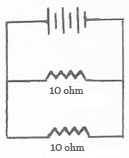
Incorrect. This circuit has a total resistance of 5 Ohms which is not the largest of the four. |
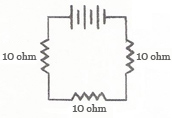
Correct! This circuit has a total resistance of 30 Ohms which is the largest of the four choices. |
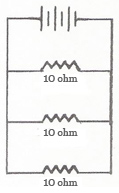
Incorrect. This circuit has a total resistance of 3.33 Ohms which is the smallest of the four. |
Two 100 Ω resistors are connected in series to a 240 V voltage source. What is the equivalent resistance of this series circuit?
- 440 Ω
Incorrect. You should only add the resistors together, not the resistors and the voltage.
- 200 Ω
Correct! Series resistors are added directly.
- 50 Ω
Incorrect. You added the resistors in parallel.
- 41.4 Ω
Incorrect. You added the resistors and the voltage together in parallel.
Three resistors, 100 Ω, 150 Ω, and 240 Ω, are connected in parallel to a 120 V voltage source. What is the equivalent resistance of this parallel circuit?
- 48 Ω
Correct! You added the reciprocals of the resistor values and then took the reciprocal of the result.
- 34.3 Ω
Incorrect. You added the resistors and the voltage source in parallel.
- 0.0208 Ω
Incorrect. You added the reciprocals of the resistor values, but forgot to take the reciprocal of the result.
- 390 Ω
Incorrect. You added the resistors in series.
Determine the equivalent resistance for the circuit shown.
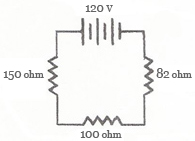
- 26.9 Ω
Incorrect. This would be the total if you added the resistors and battery together in parallel.
- 452 Ω
Incorrect. You added the resistors and the battery together.
- 34.65 Ω
Incorrect. This would be the value if the resistors were added in parallel.
- 332 Ω
Correct! The total resistance is the sum of the individual resistor values.
Determine the equivalent resistance for the circuit shown.
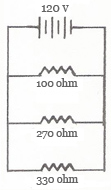
- 0.017 Ω
Incorrect. You added the reciprocals of the resistor values, but forgot to take the reciprocal of the result.
- 39.9 Ω
Incorrect. You added the resistors and the battery in parallel.
- 59.76 Ω
Correct! You correctly added the reciprocals of the resistor values and took the reciprocal of the result.
- 700 Ω
Incorrect. This would be the total if the resistors were in series.





